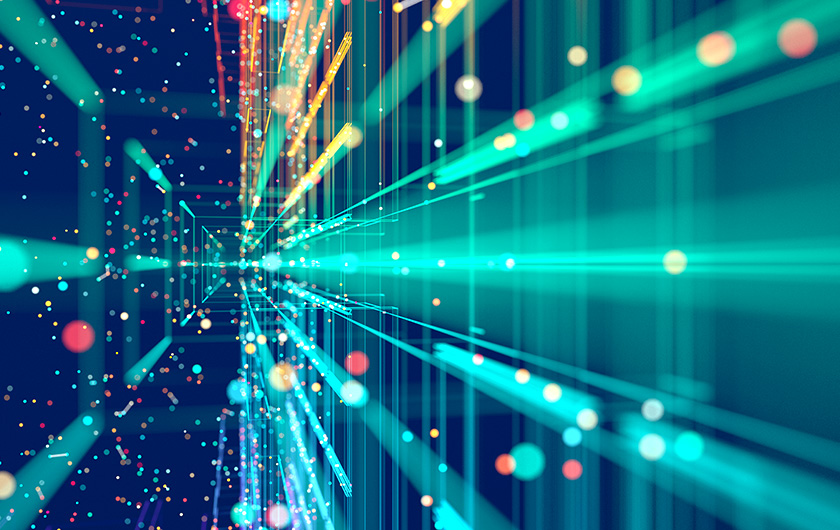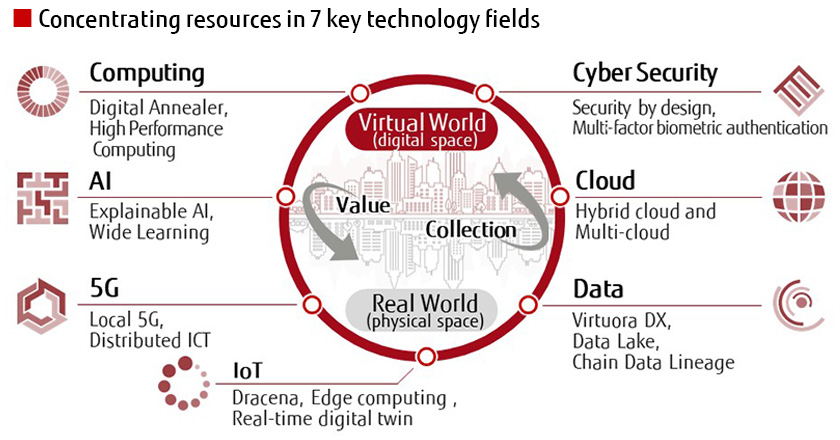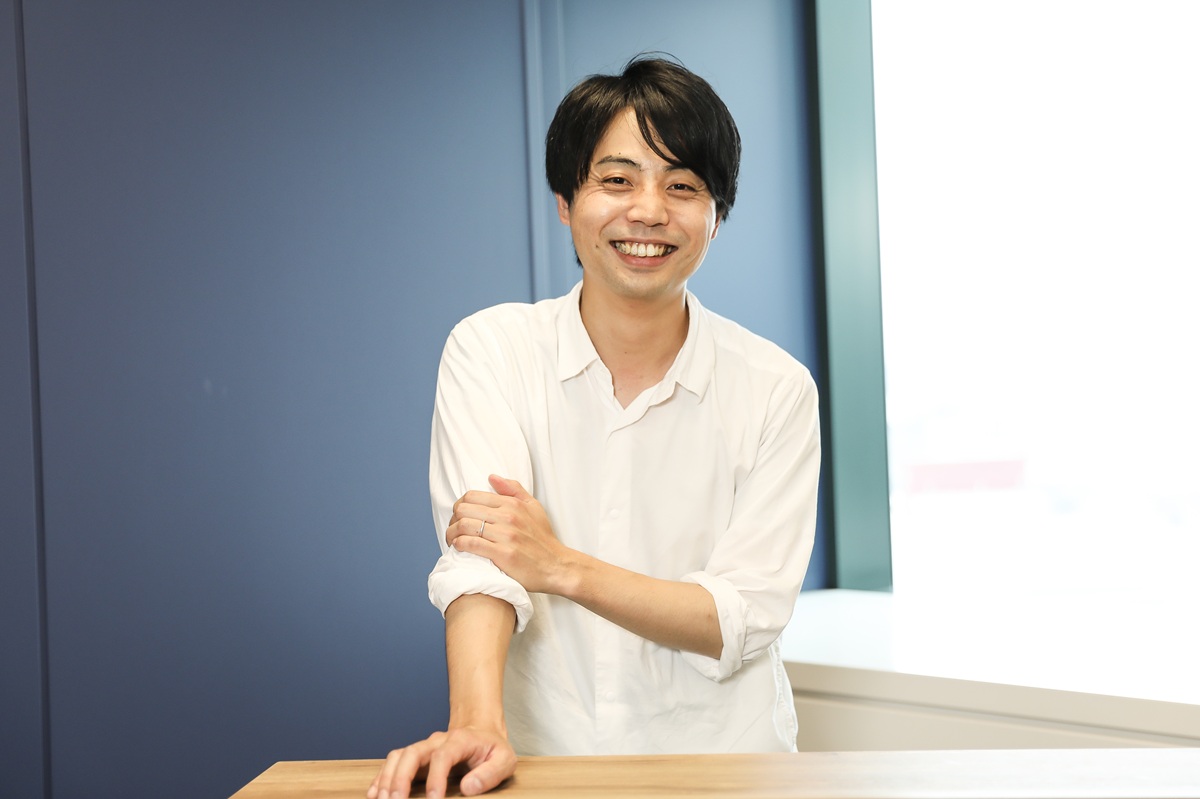
Corporate digital transformation (DX) is increasingly attracting attention. To embody and achieve DX, it’s inevitable to leverage technology. In order to drive customers’ DX businesses, Fujitsu is enhancing the development of technologies that support DX. We’re focusing primarily on seven technologcal areas: Computing, AI, 5G, IoT, cyber security, the cloud, and data. By developing these technologies, we’re striving to create the world’s top digital technologies for customers to achieve their DX businesses, while ensuring high reliability in digital and physical spaces. This article explains the challenges and our direction focusing oneach of these seven technological areas.

(Figure 1) Seven Technologies Supporting DX
Tackling unsolved complex problems
To achieve DX, it’s essential to improve computing performance and further reduce power consumption. Fujitsu has been collaborating with RIKEN to develop the supercomputer Fugaku, a successor to the K computer, which has the aim of achieving effective application performance up to 100 times faster than its predecessor. In addition, Fujitsu has been developing Digital Annealer technology for solving combinatorial optimization problems.
Using Digital Annealer, we conducted joint research with other companies, including PeptiDream. PeptiDream has a database that contains an enormous number of peptides (middle molecules) that are useful for drug discovery. To find candidate compounds for drugs using conventional computers, it usually takes several months. However, Digital Annealer ,by solving combinatorial optimization problems, is likely to increase the search speed tenfold, thus reducing the time required to approximately 10 days.
As AI technology evolves and disseminates, image recognition and speech translation have come into expanding use. This has caused an explosive increase in the amount of calculations made for AI processing - doubling over a period of 3.5 months. To meet such rising needs for calculations, Fujitsu has developed Content-Aware Computing, a new technology designed to improve performance by automatically controlling arithmetic precision.
>>For more information about Content-Aware Computing, click here.
Growing AI that is explainable, transparent, accurate and high-quality, trusted by society
Practical application of deep learning has exponentially enhanced the possibilities of AI. Going forward, AI will be used to make judgements in sports, clinical diagnoses in medical institutions, and judicial rulings in court. However, AI's judgement process is currently a black box which prevents even experts from providing the reason and basis for the answers that AI makes. This causes skepticism around the credibility of AI’s output which is why we need AI accountability, otherwise known as explainable AI.
One approach to achieving explainable AI is to combine two technologies, namely Deep Tensor and Knowledge Graph. In addition, we’ve also been working on Wide Learning, a machine-learning technology that extracts all combinations of items from training data and presents useful, uncomplicated hypotheses that serve as reasons for judgement. These technologies are the world’s first inventions to focus on AI explainability.
Recently, it has been pointed out as many problems to continue use of AI in business may lead to a tendency in which input data deviates from the original training data due to changes in social situations, market forces, and the environment. The continued use of AI in such circumstances will lead to a deterioration in AI's accuracy of estimation, that is quality of AI. To solve this problem, Fujitsu has undertaken research and development on High Durability Learning, a technology that makes it possible to estimate AI's accuracy and automatically fix AI models by annotating correct labels to input data during AI operations.
>> For more information about High Durability Learning, click here.
The accountability and ethics of AI are now being debated around the world. In 2019, the Fujitsu Group formulated a commitment to AI based on the European Commission’s ethical guidelines for AI and established the External Advisory Committee on AI Ethics. Going forward, Fujitsu will work to achieve explainable, highly transparent, accurate, and high-quality AI that is trusted by society and continues to grow.
Networking that unconsciously connects diverse data and applications;
and provides value to each and every individual
In the mobile communications industry sector, commercial fifth-generation (5G) wireless services will finally be launched in 2020. The feature of 5G isn’t only faster mobile network speeds. The true value of 5G mobile telecommunications is the ability to connect all kinds of machinery and equipment around us in order to improve quality of life and to solve social issues. Meanwhile, 5G networks can also serve as a foundation for new service models that will extend beyond the boundaries of industries and business categories.
5G can support a wide range of devices, machines, and systems, such as smart devices, automobiles, machine tools, manufacturing equipment, medical equipment, transportation infrastructure, and surveillance cameras. Diversity of terminal devices, ability to help collect enormous amounts of data, utilizing data in real-time are the key features of 5G.
To process this immense amount of data, an ICT environment for controlling resources of computers and networks between the cloud and edges in an optimized manner is essential. Fujitsu is accelerating the realization in the 5G era by providing a distributed ICT environment that has functions such as mobility support, mass data send and receive, integrated management of distributed data, and optimized resource deployment.
Even in the 5G era, Fujitsu will play a role in building base stations for telecommunications carriers just as we have before. We quickly commercialized 5G base stations, wireless equipment, and control devices in collaboration with Ericsson, a leading Swedish telecommunications equipment company. We’ve already started to deliver these products to NTT Docomo.
These network technologies can also be used to build local 5G networks that will be provided by non-carrier companies and municipalities. For instance, manufacturers can make it easy to check production sites by sending high-definition video from surveillance cameras to observers via a local 5G network. Similarly, medical institutes are working to enable doctors to see patients remotely while they remain in hospital rooms. In this way, local 5G will create many business opportunities and high social value.
Of course, the image of the future society that 5G will achieve still seems rather vague. To clarify this image, Fujitsu will hold showcases for participants to feel and experience 5G society in advance as well as collaboration labs with 5G partners throughout Japan. We will draft the future of 5G society through 5G value experience events open to everyone.
Data, IoT, cyber security, and the cloud
As data is used in more diverse areas, privacy risks around secure data distribution and personal information are increasing. Effective use of big data cannot be promoted until we have eliminated such concerns. This means addressing the possibility that data may be compromised in transit and personal data may be used without permission or without being noticed by the owner. To this end, Fujitsu has addressed a research project with the top priority of establishing reliable digital-native data management for a data-driven society.
In the IoT field, the number of device connecting to networks is predicted to reach 80 billion worldwide in fiscal 2020. To make the most use of these devices, it’s important to enable real-time data processing and to provide context of the data as well as experiences focusing on social nature. To display the IoT's true worth, it’s inevitable to conduct research and development on Real-Time Digital Twins. This processes large-scale data and applications and improves user and customer experience (UX/CX). Currently Fujitsu Laboratories Ltd. is working on technologies such as: Dracena, a telematics technology for processing information on more than 10 million vehicles; KIDUKU, a technology for observing walking characteristics; and services that use Visual-SLAM, a technology for 3D positioning autonomous driving. In the cyber-security area, we aim to provide solutions based on practical knowledge acquired through cloud-related CSIRT* activities. These achieve a safe, secure, hands-free cashless payment system based on biometric authentication and encryption technologies that shoppers can use just by being presents.
Cloud as a fundamental technology that accelerates these DX technologies is expectedto expand both in market size and innovation. In anticipation of this expansion, Fujitsu is focusing on managed service automation and cloud-native development. In the cloud area, instead of developing everything by ourselves, we we’ll encourage open innovation with partners, including coordination with cloud vendors.
Fujitsu has led the world by developing many innovative technologies and delivering new value to people, society, and businesses. Technology's mission is to empower people and enable them to live better lives through completely new experiences and value. Fujitsu will continue to bring happiness to people worldwide by developing society through technologies.
*: Computer Security Incident Response Team. A general term used to refer to organizations that respond to incidents related to computer security.











